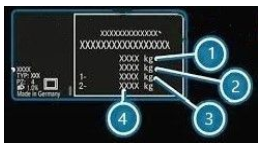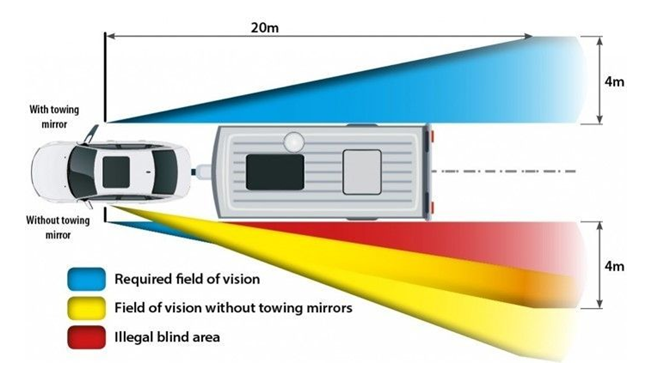Right, where to start?
A popular question we get asked is how to calculate vehicle towing limits, so here we go!
It is vitally important that you do not exceed your vehicles maximum towing capacity when towing a caravan or trailer. Failure to comply with this ruling could result in fines, prosecution, points on your driving license and loss of insurance. It could also endanger your life, lives of your loved one's and people around you.
To work out what your vehicle can legally tow you need to locate your vehicles VIN plate. This is usually positioned either under the bonnet or inside one of the door apertures of the vehicle.
In the centre of the plate you should have 4 weights:
1. Gross Vehicle Weight (GVW) this is the maximum weight of the vehicle.
2. Gross Train Weight (GTW) this is the total maximum weight of the vehicle plus trailer/caravan.
3. Maximum Front Axle Load
4. Maximum Rear Axle Load

To calculate the maximum towing capacity of the vehicle simply subtract figure 1 from figure 2.
EG GTW (2) 4500 kg less GTW (1) 2500 = 2000kg maximum towing capacity.
This is a legally binding figure and must not be exceeded.
IMPORTANT! If the figure at position two is '0' or the panel is empty, (no printed weights) you cannot legally tow with your vehicle.
Towing with the vehicle could lead to prosecution and invalid insurance.
Before deciding which caravan or trailer to purchase it is important to consider safe towing guide lines suggested by organisations such as the Caravan Club or the Camping and Caravaning Club. For reasons of safety and stability they advise an 85% safe towing limit. Basically you need to refer to your vehicles hand book, find the vehicles kerb weight and multiply the vehicles kerb weight by 85%
EG 1800 kg kerb weight multiplied by 85% = 1530 kg
This is your SAFE TOWING LIMIT . Please also bear in mind that this figure MUST NOT exceed the Maximum Towing Capacity of the vehicle. If this is the case then the lower figure will apply. In theory you can tow up to 100% of your car's kerbweight (as long as you don't exceed the maximum towing limit of your vehicle) but specialist organisations certainly wouldn't recommend it for a beginner.
Please note that the information above only relates to trailers/caravans fitted with a braking system.
If you are considering purchasing an un-braked trailer the the maximum gross trailer weight cannot exceed 750kg.
To calculate your unbraked towing limit you need to multiply your vehicles kerb weight by 50%, whichever is the lower figure is your unbraked towing limit. Just remember you cannot legally tow an unbraked trailer which weighs more than 750kg gross weight. Also you must not exceed the maximum plated towing limit of your vehicle.
You must also consider any limits or restrictions applied to your driving license. The latest information can be found on the GOV.UK website.
(Please note that information given in this guide relates to passenger vehicles for private use only (not commercial vehicles or business use).
Type Approved Towbars
Type approval regulations (EC94/20) were introduced into the UK on the 1st August 1998 ('S' registration), this has since been adapted to reg 55. Type approved towbars must fit to all of the vehicle mounting points stipulated by the vehicle manufacturer and conform to the vehicle manufacturers specifications. Towbars are put through a rigorous test procedure overseen by the VCA (Vehicle Certificate Agency). Once the tests have been passed the towbar is given a unique approval number and must be fitted with a data plate containing required information.
It is illegal to install a non type approved towbar to a type approved vehicle.
Vehicles registered before the 1st August 1998 or vehicles which do not conform to European Whole Vehicle Type Approval (eg Japanese import vehicles) do not require a type approved towbar.
Towball Height.
Towball type approval dictates that a towball height must be between 350mm to 420mm, to the centre of the towball, with the vehicle in a laden state. The laden weight could mean a vehicle fully laden to its Gross Vehicle Weight or conventionaly laden which is defined as 68.5kg per specified passenger seat and 6.5kg of luggage per specified passenger and located in the centre of the luggage storage area, the specifiaction used is determined by the vehicle manufacturer. It may also be at a height or within a height range specified by the vehicle manufacturer in the vehicles homologation documentation.
This is certainly not a simple measurement to determine. It is generally the case that a drop plate cannot legally be used to lower the towball height, although a limited number of towbars may have been type approved by the towbar manufacturer to allow use. A towball must never be raised above its intended/tested position.
Maximum Trailer/Caravan Dimensions:
Towing Vehicles upto 3500kg GVW:
Length excluding drawbar/coupling 7 metres.
Width 2.55 metres.
Towing Vehicles over 3500kg GVW:
Length excluding drawbar/coupling 12 metres
Width 2.55 metres
Length of towing vehicle and trailer/caravan 18metres
Speed Limits When Towing:
30mph on all roads with street lighting unless a sign shows otherwise.
50mph on single carriageway roads unless a sign shows otherwise.
60mph on dual carriageways or motorways.
Please note: you must not travel in the outside lane of a 3 or more lane motorway when towing.
Towing Mirrors:
Towing mirrors must be used if the caravan or trailer being towed is wider than the towing vehicle.

Legal requirements specify that you must have a clear field of vision 4 metres either side of the caravan/trailer and 20 metres behind the caravan/trailer (from the drivers seat).
Caravan/ Trailer Coupling Height
The EC directive for coupling heights states that the coupling height of a caravan/trailer should be between 385mm and 455mm with the unit fully laden.
In this instance fully laden means loaded to the MTPLM (maximum technically permissible laden mass) of the caravan/trailer. This figure is determined by the manufacturer.
Caravan Noseweight
The noseweight of a caravan is the downward load weight exerted by the caravan's hitch on the vehicles towball. A general guide is that a caravan noseweight is in the range of 5% to 7% of the MTPLM. The actual noseweight of a caravan is generally between 75kg and 100kg, but you must ensure your caravan noseweight does not exceed the noseweight specified by the vehicle/towbar manufacturer.
The best way to check and measure your noseweight is to purchase a noseweight gauge.
Stabilisers:
A well matched car and caravan/trailer outfit, when carefully loaded, will be inherently stable but the additional assistance a stabiliser gives can assist in giving an easier, more comfortable journey. This is especially the case when experiencing cross winds or the 'bow waves' off overtaking vehicles.
The most popular type of stabilisers are built into the hitch of the trailer/caravan using friction pads to grip onto a dry towball. Depending on the towbar and stabiliser type you may also be required to change your towball. Alternatively leaf spring style stabilisers are also available.
Always remember that a stabiliser is not a solution to a miss matched outfit or a poorly loaded trailer/caravan.
ATC. Active Trailer Control
ATC is an anti-snake system designed to lightly apply the caravan brakes whenever the trailer starts to sway (snake) beyond certain prescribed limits. Some caravan movement is natural, but if ATC monitors the caravans sway and detects that they are increasing rather than decreasing, it briefly applies the caravan brakes bringing the caravan back into line. It will not react to sudden movements that self-correct or in normal cornering situations. ATC uses an electronic black box that bolts onto the caravan axle and then connects to the brake actuation rod. The system relies on the black box getting a constant 12 volt supply which needs to be provided via the 13pin or 12S seven pin socket on the towing vehicle. Each time you hitch up the system will carry out a ‘self-check' to ensure it is receiving a constant live connection, this is indicated via an LED readout on the caravan drawbar which changes from red to green.
Numerous caravan manufacturers install ATC as standard or offer it as an option on new caravans. Alternatively if you are purchasing a used caravan the system may be able to be retrofitted.
Towcraft Ltd gives no warranty and accepts no responsibility or liability for the accuracy or the completeness of the information and materials contained in this guide. Under no circumstances will Towcraft Ltd be held responsible or liable in any way for any claims, damages, losses, expenses, costs or liabilities whatsoever (including without limitation any direct or indirect damages for loss of profits, business interruption or loss of information) resulting or arising directly or indirectly from your use or ability to use this guide or any websites linked to it, or from your reliance on the information and material on the guide.





